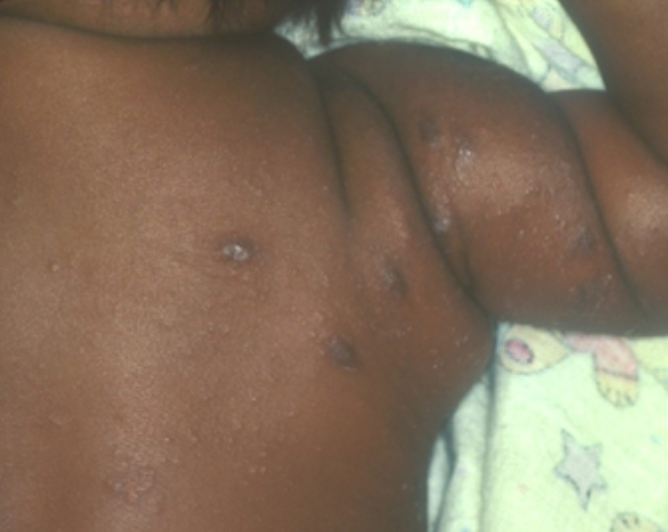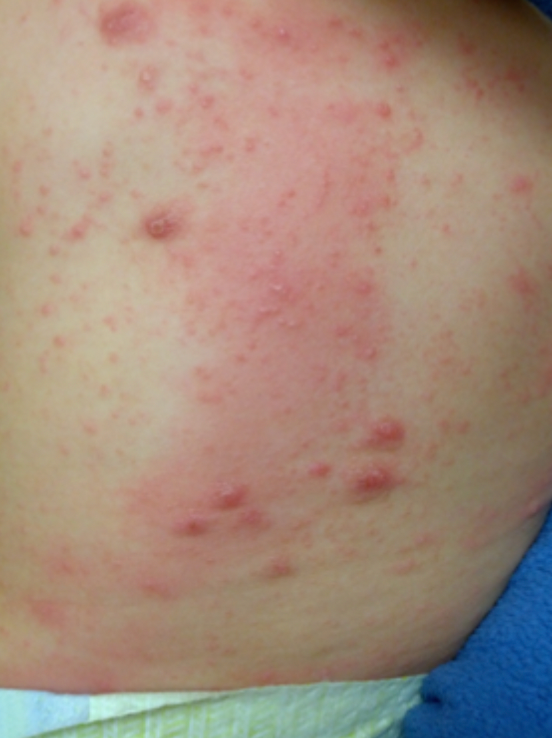- General Dermatology
- Eczema
- Alopecia
- Aesthetics
- Vitiligo
- COVID-19
- Actinic Keratosis
- Precision Medicine and Biologics
- Rare Disease
- Wound Care
- Rosacea
- Psoriasis
- Psoriatic Arthritis
- Atopic Dermatitis
- Melasma
- NP and PA
- Skin Cancer
- Hidradenitis Suppurativa
- Drug Watch
- Pigmentary Disorders
- Acne
- Pediatric Dermatology
- Practice Management
A Novel Approach to Distinguishing Scabies From Atopic Dermatitis
The WHO underscores the significance of addressing scabies as a neglected skin disease, especially in regions with limited health care access.
Figure 1. Infant with recurrent eczematous rash initially treated with topical emollients and steroids showing significant improvement following diagnosis and treatment of scabies | Image Credit: Bernard Cohen, MD

Dermatologic conditions often present diagnostic challenges due to overlapping clinical features. Among these, scabies and atopic dermatitis (AD) share similarities, leading to potential misdiagnosis and delayed treatment.1 Findings from a recent study shed light on distinguishing between these conditions, offering clinical insights for dermatologists.2
Scabies, caused by Sarcoptes scabiei hominis, manifests as an intensely pruritic rash with characteristic burrows and papules. In 2017, the World Health Organization categorized scabies as a neglected tropical skin condition and public health concern in developing countries.3 It can also be misdiagnosed in North America and Europe. This parasite affects an estimated 150 to 200 million people worldwide each year.4 Despite distinct pathogenesis, the clinical presentations of AD and scabies can overlap, posing a diagnostic dilemma.
Figure 2. Similar disease course as Figure 1 on lighter skin tone | Image Credit: Bernard Cohen, MD

Importance of Differentiating
The World Health Organization underscores the significance of addressing scabies as a neglected topical skin disease, especially in regions with limited health care access. Effective management strategies are crucial to mitigate scabies-related morbidity and transmission. Although scabies typically presents as a pruritic rash with characteristic burrows, its variable clinical presentation poses diagnostic challenges.
The overlapping clinical features with AD further complicate diagnosis, potentially leading to treatment delays and suboptimal outcomes. Despite differing causes—scabies from Sarcoptes scabiei mite infestation and AD from genetic, immunologic, and environmental factors—both conditions share common manifestations, including intense pruritus as well as erythematous, scaly papules and patches in healthy individuals with intact immunity.
Clinicians can rely on a combination of clinical assessment and diagnostic tests for accurate identification. Improving diagnostic accuracy and treatment protocols is essential due to scabies’ global prevalence. Advancements in diagnostic methods such as dermoscopy and molecular testing offer promise for precision, especially in ambiguous cases. Ongoing research into new treatment modalities aims to enhance efficacy and reduce recurrence. By addressing diagnostic challenges and adopting evidence-based management, dermatologists can effectively lessen the burden of scabies and improve care globally.
The Study and Key Findings
Recent research conducted by dermatologists aimed to identify clinical features aiding in the differentiation between scabies and AD. The study included a comprehensive analysis of patient demographics, symptomatology, and diagnostic methods to establish reliable criteria for distinguishing between the 2 conditions.
The study results revealed 4 crucial findings:
1 Pruritus characteristics. Although both conditions typically present with itching, the pattern and intensity of pruritus differed. Patients with scabies reported more intense itching, often worsening at night, attributed to the burrowing activity of scabies mites.2
2 Lesion distribution. The distribution of lesions varied between scabies and AD. Scabies lesions favored interdigital spaces, flexural areas, and genitalia, reflecting the predilection of scabies mites for these sites. In contrast, AD lesions tended to spare these regions, favoring the exposed areas of the face, neck, and extensor surfaces.2
3 Response to treatment. Response to treatment served as a valuable diagnostic indicator. Patients with scabies demonstrated rapid improvement following scabicidal therapy, whereas those with AD typically required longer-term management with topical corticosteroids and emollients.2
4 Diagnostic modalities. The study results highlighted the importance of diagnostic modalities in confirming the diagnosis. Although scabies diagnosis relied on visualizing mites, eggs, or fecal matter, AD diagnosis often involved positive family history, clinical examination, and exclusion of other conditions.2
Implications for Clinical Practice
The study’s findings carry significant implications for clinical practice. Improved diagnostic accuracy can be achieved by recognizing subtle differences in clinical features and employing appropriate diagnostic methods. This enhancement in accuracy facilitates timely and effective management, ensuring that patients receive the most appropriate care.
The classic presentation of scabies includes serpiginous white lines and erythematous papules, often accompanied by intense nocturnal itching.2 Diagnosis relies on recognizing these distinctive features, with confirmation through visualization of mites, eggs, or fecal pellets. However, atypical presentations, particularly in patients with debilitation or those with compromised immune systems, may confound diagnosis, delaying treatment. Topical permethrin and oral ivermectin are commonly prescribed treatments, with spinosademerging as a promising alternative. Challenges such as pseudoresistance and postscabetic prurigo underscore the importance of proper adherence to treatment protocols and ongoing research for improved strategies.2 Additionally, cases involving close contacts necessitate comprehensive treatment to prevent reinfestation, emphasizing the critical role of patient education and adherence to preventive measures.
Accurate differentiation between scabies and AD enables clinicians to tailor treatment approaches according to the specific condition. Prompt initiation of scabicidal therapy for scabies and targeted anti-inflammatory therapy for AD can alleviate symptoms and prevent complications, leading to improved patient outcomes.
Preventing misdiagnosis is paramount to avoid unnecessary treatments and potential complications. Clinicians must maintain a high index of suspicion for scabies, particularly in populations at high risk, to avoid diagnostic pitfalls and ensure appropriate management strategies are implemented (Figures 1 and 2). These measures collectively contribute to optimizing patient care and minimizing the burden of dermatologic conditions on individuals’ health.
Conclusion
Findings from the recent study provide insights into differentiating scabies from AD, offering a road map for clinicians encountering similar diagnostic challenges. By understanding distinct clinical features and using appropriate diagnostic modalities, clinicians can accurately diagnose and effectively manage these conditions, ultimately improving patient outcomes and quality of life. Continued research in this area is warranted to further refine diagnostic criteria and enhance clinical practice in dermatology.
Author Bios
Isabella Tan is from Potomac, Maryland, and is a third-year medical student at Rutgers Robert Wood Johnson Medical School in New Brunswick, New Jersey.
Bernard Cohen, MD, is a professor of pediatrics and dermatology at Johns Hopkins University School of Medicine in Baltimore, Maryland.
References
1. Ricciardo BM, Kessaris HL, Kumarasinghe SP, Carapetis JR, Bowen AC. The burden of bacterial skin infection, scabies and atopic dermatitis among urban-living Indigenous children in high-income countries: a protocol for a systematic review. Syst Rev. 2022;11(1):159. doi:10.1186/s13643-022-02038-8
2. Hesari R, Schur N, Tyndall N, Chuchla T, Gazy N. The itchy truth about scabies: a case of asymptomatic carrier transmission and treatment failure. Cureus. 2023;15(12):e50744. doi:10.7759/cureus.50744
3. Engelman D, Marks M, Steer AC, et al. A framework for scabies control. PLoSNegl Trop Dis. 2021;15(9):e0009661. doi:10.1371/journal.pntd.0009661
4. Bernigaud C, Fischer K, Chosidow O. The management of scabies in the 21st century: past, advances and potentials. Acta Derm Venereol. 2020;100(9):adv00112. doi:10.2340/00015555-3468

